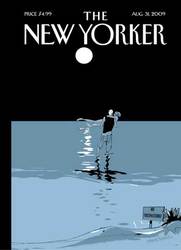Emdashes—Modern Times Between the Lines
The Basics:
About Emdashes | Email us
Ask the Librarians
Best of Emdashes: Hit Parade
A Web Comic: The Wavy Rule
Features & Columns:
Headline Shooter
On the Spot
Looked Into
Sempé Fi: Cover Art
Sempé Fi (On Covers): Don't Forgive Us Our Trespasses
Filed under: Sempé Fi Tagged: art, beach, covers, Istvan Banyai, Martha's Vineyard, Pollux

Pollux writes:
“No Trespassing!” a sign warns, as a couple wades into the surf at nighttime. It is a forbidden tryst, involving the romance of a midnight hour and a private beach to which they are not allowed access. The sign is small and ineffective; the power of love and lust is not.
It is a New Yorker cover in which the cool grays, whites, and blacks of the coloring are working against the hot passion of a couple who may be about to make love in the surf. There is a touch of danger in the air, and as is usually the case with New Yorker covers, a touch of mystery as well.
Danger lurks in the air. I can’t help thinking that, yes, the couple may be intent on a sexual thrill, but the moonlit pathway to the sea seems also to lead to death -either by murder or by suicide.
As one blogger has written, Banyai’s cover “manages to be romantically touching despite the fact that it automatically summons to mind the open scene of Jaws.”
The cover of the August 31, 2009 issue of The New Yorker, called “No Trespassing,” seems to be a parody of a romantic moonlit scene. A full moon is a commonplace symbol of romance and romantic trysts. Don’t lovers ever fall in love beneath the glow of a waxing gibbous or third quarter moon?
The cover’s artist is Istvan Banyai, a Hungarian-born artist who now lives and works in New York and Connecticut. As Banyai has remarked, “I like visual, I think visual.” His children’s book Zoom is all about visuals: the book is composed of a slow and steady zooming out over the course of many pages.
Body language is everything. The legs of the woman are not draped gracefully and seductively across her man’s arms. She seems to flail rather gracelessly in the night air. Her knees are pointed against one another. Her pose is ungainly.
Nevertheless, her face is turned towards him, her eyes closed, her lips ready. She seems to be entirely naked. Her partner is clothed. Instead of a white tux or From Here to Eternity swimming trunks, however, the man wears a tank top and shorts that sag unattractively down his buttocks.
Banyai’s May 6, 2002 cover also depicted a couple who made up for any lack of elegance with sexual passion: the boy wears an ill-fitting tank top that reveals skinny arms and a belly button.
The girl wears a summer dress, a bandanna, and no bra. She extends a long arm around him; his arm simply hangs across her shoulders. They kiss in a city street infused with a creamy yellow and with people bustling off to work. The commuters are boring and bored, and their nipples aren’t showing.
Banyai’s drawings of intertwined couples place the focus on their bodies, on their physicality. His couples are not perfect physical specimens, just regular couples who have managed to find a moment of passion and sexuality.
Where are they? Are they, perhaps, on one of Martha’s Vineyard’s coveted “key beaches”? These are beaches that require a key to get in, but according to this article, people still manage to sneak in. Gates are scaled, keys are duplicated and hidden under rocks, and visitors “accidentally” wander onto association beaches.
The rules regarding beach trespassing seem to be a little hazy, although most authorities consider public property everything seaward of the mean high water line—the mean high water line being the average level of the high tide line over the last 19 years.
There is no political or social message on the cover, and Banyai’s cover is not about beach property rights at all. (In any case, even an advocacy group like C.R.A.B., the Citizens’ Right to Access Beaches, declares very categorically the following: “We respect the rights of private property owners and do not advocate trespassing.”)
The cover’s intent is to evoke a scene of romance, of sex and danger. It is about the thrill of public nudity. It is about the thrill of wearing any old thing, or nothing at all, and still having someone who wants you.
Banyai’s couple does not seem to be worrying about high tide levels and property rights. They are trespassing and transgressing. Love, or at least lust, is in the air.




